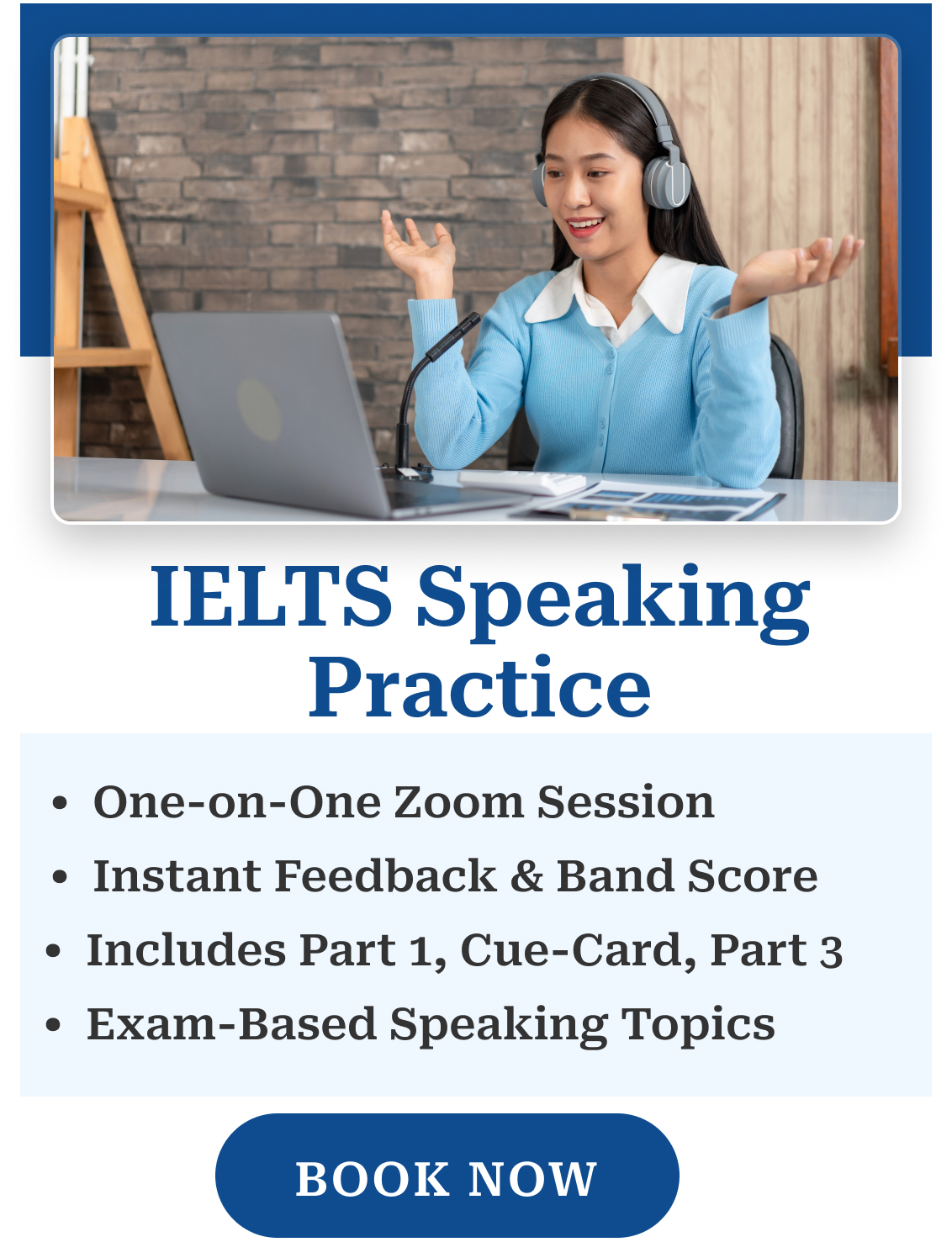Guide to IELTS 9 Band Score
- 0 Comments


The IELTS (International English Language Testing System) exam is designed to test non-native speakers’ English proficiency. It is often used to complement admissions to academic institutions and immigration purposes, and it can even be a bonus for your professional certification or LinkedIn profiles. IELTS can be taken on computer aka Computer-delivered IELTS or Computer-based IELTS and Paper-based IELTS. The test is split into four key sections: Reading, Listening, Writing, and Speaking.
Table of Contents
1. IELTS Format & Test Report Form (TRF)
The IELTS test is 2 hours and 45 minutes long and split into 4 sections:
- Listening: 40 questions, 30 minutes
- Reading: 40 questions, 60 minutes
- Writing: 2 writing tasks, 60 minutes
- Speaking: 3 parts, 11-14 minutes
Note that the Listening, Reading, and Writing tests are taken in one sitting, and the Speaking test will be conducted on the date you choose during your registration or your test venue may choose one for you as well.
After completing the IELTS, you will receive a Test Report Form (TRF), which gives your score on each section (out of 9) and an overall band score out of 9.
2. IELTS Band Score Explained
The IELTS is scored on a scale of 0 to 9. According to the official IELTS page, a score of 9 indicates the level of an Expert. Each test section is scored separately on this scale and averaged for the overall band score. Use this IELTS Band Score Calculator to calculate your IELTS bands. Here’s a rough idea of what each band score means:
- Band 9: Expert
- Band 8: Very Good
- Band 7: Good
- Band 6: Competent
- Band 5: Modest
- Band 4: Limited
- Band 3: Extremely Limited
- Band 2: Intermittent
- Band 1: Non-user
- Band 0: Did not attempt the test.
From 2022, you now have the option to take the IELTS online, also called IELTS computer-delivered or CD IELTS. This means you can take the IELTS virtually in your home or any environment you prefer. You will also receive your IELTS score within 6-8 days after you have taken the test.
3. Listening
Here are the main ways the IELTS assesses your listening skills:
- How well can you understand the main ideas and essential factual information?
- How well can you follow the development of an argument made?
- How well can you recognize the attitudes, views, and purpose of the speakers?
3.1 Listening Format
Here is the format of the listening test:
- Recording 1: a conversation between two people based on an everyday context.
- Recording 2: a monologue of a speaker set in an everyday context
- Recording 3: a conversation between up to four people in an educational/training context.
- Recording 4: a monologue on an academic subject
3.2 Listening Question Types
Based on these 4 recordings, the listening test has 40 questions split into different question types:
3.3 Pro-Tips for Listening
- Surround yourself with the English language: listen to podcasts and IELTS audio tests. This will expose you to the language constantly and help you become more comfortable.
- Fill in your answers in the answer sheet! Don’t wait until the audio ends to write down your answers.
- Always maximize your time! Use the time given at the end to review the questions and determine what you can expect and what kind of answer you want.
- You must also try to use the exact words the speaker uses in your response to guarantee that you answer the questions correctly.
- Practice as many IELTS listening tests as possible. As the saying goes, practice makes perfect.
4. Reading
In the reading section, IELTS is specifically looking for:
- How well do you understand and read the main ideas
- How well you can read for detail
- How well you can understand inferences and implied meaning
- How well you can recognize the opinions and perspectives of the writer
- How well you follow the development of an argument.
4.1 Reading Format
Here is the format of the reading test:
- Academic IELTS: Three long passages that range from descriptive to analytical are normally taken from books and other literary sources.
- General Training IELTS: Passages are selected based on what you would likely encounter in an English-speaking environment. Part 1 contains 203 short texts, Part 2 contains two texts and Part 3 contains one long text.
4.2 Reading Question Types
Note that each passage has approximately 3-4 different question types to answer. Here are the different question types:
4.3 Pro-Tips for Reading
- Use your time efficiently: Spend more time on tougher passages. Target using 15-20 minutes on the easier passages.
- Dump your bias: Approach the test without bias. Do not make assumptions, and always answer the questions based on the passage, not based on what you think. ALWAYS remember that the answers to the questions are only in the passage.
- Read the questions first: Reading the questions before tackling the passage can help you focus on what they are asking.
- Don’t read the whole passage in detail: You will lose a lot of time by doing so. Instead, read the question and check whether there are any keywords, and then look at the passage and find the part you need to read more closely.
- Know the question types: Look at the question types listed above. They are always the same.
- 10/20/30: Take approximately 10 minutes for section 1, 20 for section 2, and 30 for section 3.
- Highlight keywords from the question. This will help you pinpoint information much faster and focus only on the necessary information.
- Read more: Read on topics that you aren’t interested in. By doing so, you can improve your concentration.
- Don’t overcomplicate it: If there is a word you do not understand, you should move on. You only have a limited amount of time. Or if the word is important, you can look at the words and sentences around it for clues about its meaning. Focus on the word that are directly related to the questions. Don’t worry too much about the words you do not understand.
5. Writing
In the writing section, the IELTS is looking for:
- How well you write a response
- How effectively you organize ideas
- How well you use vocabulary and accurate grammar
5.1. Writing Task 1 Format
- General Training Task 1 is a 150-word response to a situation in the form of a letter.
- Academic Task 1: 150 words report on describing a table, graph, chart, or diagram
5.2. GT Task 1 Letters Types
- Formal Letter
- Semi-formal letter
- Informal letter
5.3. Academic Task 1 Report Types
Here are the different question types:
5.4. Writing Task 2 Format
- Task 2: Write at least 250 words on an essay topic
5.5. Task 2 Essay Types
5.6 Pro-Tips
- Allocate your time wisely: Aim to spend just 20 minutes on the first task and 30 minutes on the second task. With the remaining time, proofread your writing to reduce grammatical and spelling errors.
- Study sample 9 band answers: Read sample band 9 essays. Focus on the introduction, how the writing conveys the main points, and how the writer concludes up the essay.
- Stick to 2 arguments for each side: This is a safer way to approach the writing section because you can go into depth to each argument without exceeding the word limit for writing task two. Remember that the examiners are looking for structure and how you can get your points across!
- Logical approach: make sure that you logically organize your essays. Ideas must be expressed clearly to hit the higher bands. For example, if you are asked to present both views, start with your opinion initially and then move on and argue for both sides. Then, come back to your own opinion and conclude the essay.
- E.E: Use this simple acronym when you’re starting your body paragraphs. P stands for Point. Introduce your topic and your main point. E stands for Evidence. Provide an example that supports your point. The other E stands for Explanation. Explain your evidence/example and how it supports your point.
- Utilize a hook: The first sentence of your written portion should be able to “hook” a reader’s attention. Make sure that your first sentence is eye-catching and engaging to read. Eg. “The effects of global warming are irreversible unless we act now.”
- Make sure your responses are specific and not generalized: Overgeneralizing the topic would make you lose marks. Ensure you are specific in your essays and write about what the examiner wants you to write about.
- Answer the question completely: Read the question carefully before you start and decide how many elements or parts the question has. Make sure that you answer ALL of the parts in your response. E.g. If a question asks, “Discuss both views on international tourism. Is international tourism beneficial, or is it harmful to a country?” then you must present your opinion and then discuss the two sides of the argument.
6. Speaking
In the speaking section, the examiner wants to see:
- How you communicate your opinions and information on everyday topics
- How you speak at length on a given topic using proper language
- How you organize ideas
- How you express and expand on your opinions
- How you analyze and discuss issues
6.1 Speaking Format
Here is the format of the speaking test:
- Part 1 Introduction: The examiner will introduce himself/herself and then ask you to introduce yourself and confirm your identity. They will also ask you several starting questions that require 1-2 sentences of response.
- Part 2 Cue-Card: The examiner will give you a task card with a topic you must discuss. You are given one minute to prepare and then talk for 1-2 minutes without interruption.
- Part 3 Discussion: The examiner will ask questions connected and built from part 2.
6.2 Pro-Tips
- Imagine that the examiner is your friend: Be comfortable and confidently speak to the examiner. Make sure that you don’t lose eye contact.
- Natural Speaking: Make sure you speak audibly and let your words flow naturally. This can be achieved by keeping your lexical skills straightforward.
- Throw in some impressive words: When you have the chance, impress the examiner using more advanced words.
- Don’t worry about what the examiner will think of your response: Sure, it’s a lot of pressure to talk to an examiner. But sometimes, it is best not to overcomplicate things. Don’t analyze their responses or body language. Always remember that the examiners are just here to assess your use of language and how well you can speak in English, not judge you as a person based on your opinion.
- Stick to your opinions: It’s natural to talk more comfortably and logically when speaking with your own opinion. You don’t need to agree with everything that the examiner is saying. The conversation is likely to get more engaging if you have differing views from your examiner. Remember that the exam is about YOU. How you can carry a conversation and how you can speak your own mind.
- Don’t fake an accent: You might be tempted to fake a native accent, but keep in mind that you are not evaluated based on how unique you sound. Just focus more on what is actually important to your score: your fluency, grammar, logical reasoning, and pronunciation.







